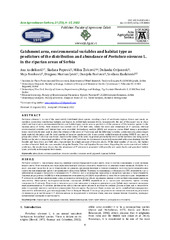Приказ основних података о документу
Catchment area, environmental variables and habitat type as predictors of the distribution and abundance of Portulaca oleracea L. in the riparian areas of Serbia
| dc.creator | Anđelković, Ana | |
| dc.creator | Popović, Slađana | |
| dc.creator | Živković, Milica | |
| dc.creator | Cvijanović, Dušanka | |
| dc.creator | Novković, Maja | |
| dc.creator | Marisavljević, Dragana | |
| dc.creator | Pavlovic, Danijela | |
| dc.creator | Radulović, Snežana | |
| dc.date.accessioned | 2023-07-08T15:00:08Z | |
| dc.date.available | 2023-07-08T15:00:08Z | |
| dc.date.issued | 2022 | |
| dc.identifier.issn | 0354-9542 | |
| dc.identifier.issn | 2560-3140 | |
| dc.identifier.uri | https://plantarum.izbis.bg.ac.rs/handle/123456789/618 | |
| dc.description.abstract | Portulaca oleracea L. is one of the most widely distributed plant species, invading a host of worldwide regions. Rivers and canals, as corridors connecting neighboring habitats, are known to exhibit high invasion levels. Consequently, the aim of this paper was to show which catchment areas, environmental factors and habitat types can be seen as predictors of the presence of this invasive species in the riparian areas of Serbia. Field research was carried out at 250 field sites, where the cover and abundance of P. oleracea, relevant environmental variables and habitat type were recorded. Redundancy analysis (RDA) and response curves fitted using a generalized linear model (GLM) were used to show the relation of the cover of P. oleracea and the following variables: catchment area, predominant bank material, elevation, and the total number of invasive species on site. A non-metric multidimensional scaling (NMDS) was used to group sites where P. oleracea was found, based on the values of its cover. In general, primarily the rivers in the northern, low-lying part of Serbia can be seen as important corridors of the spread of P. oleracea. Its dominance is especially associated with areas draining into the Danube and Sava rivers and field sites characterized by a high pressure of invasive plants. Of the total number of records, the highest number of invaded field sites was recorded along the Danube, Tisa and Zapadna Morava rivers. Regarding the environmental and habitat predictors, the results have shown that the abundance of P. oleracea is associated with gravelly and sandy banks and grassland habitat types, primarily anthropogenic herb stands. | sr |
| dc.language.iso | en | sr |
| dc.publisher | Univerzitet u Kragujevcu - Agronomski fakultet, Čačak | sr |
| dc.relation | info:eu-repo/grantAgreement/MESTD/inst-2020/200010/RS// | sr |
| dc.relation | info:eu-repo/grantAgreement/MESTD/inst-2020/200032/RS// | sr |
| dc.relation | info:eu-repo/grantAgreement/MESTD/inst-2020/200178/RS// | sr |
| dc.rights | openAccess | sr |
| dc.rights.uri | https://creativecommons.org/licenses/by/4.0/ | |
| dc.source | Acta Agriculturae Serbica | sr |
| dc.subject | alien plants | sr |
| dc.subject | common purslane | sr |
| dc.subject | invasion corridor | sr |
| dc.subject | invasive weed | sr |
| dc.subject | pigweed | sr |
| dc.subject | riparian habitat | sr |
| dc.title | Catchment area, environmental variables and habitat type as predictors of the distribution and abundance of Portulaca oleracea L. in the riparian areas of Serbia | sr |
| dc.type | article | sr |
| dc.rights.license | BY | sr |
| dc.citation.epage | 15 | |
| dc.citation.issue | 53 | |
| dc.citation.rank | M24 | |
| dc.citation.spage | 9 | |
| dc.citation.volume | 27 | |
| dc.type.version | publishedVersion | sr |
| dc.identifier.doi | 10.5937/AASer2253009A | |
| dc.identifier.fulltext | http://plantarum.izbis.bg.ac.rs/bitstream/id/2679/bitstream_2679.pdf |


